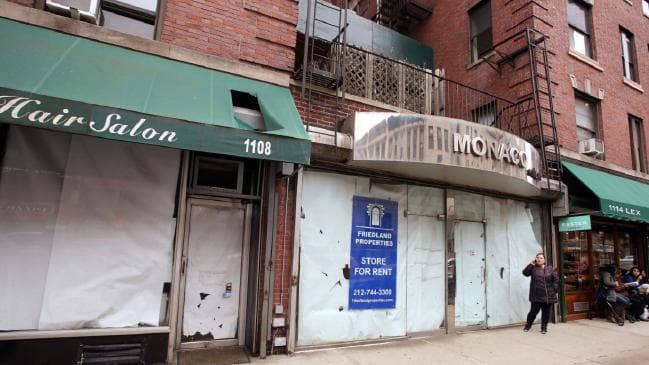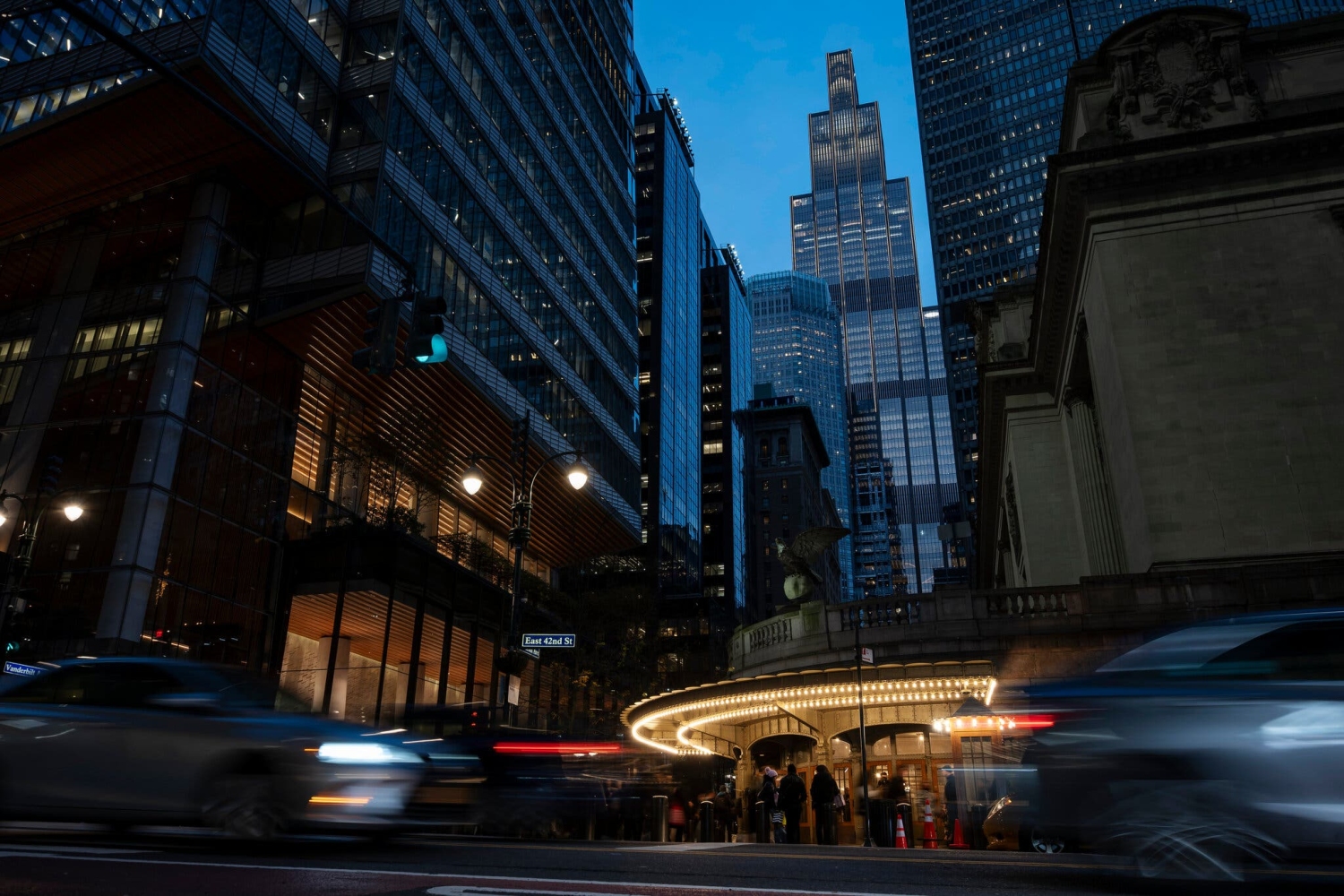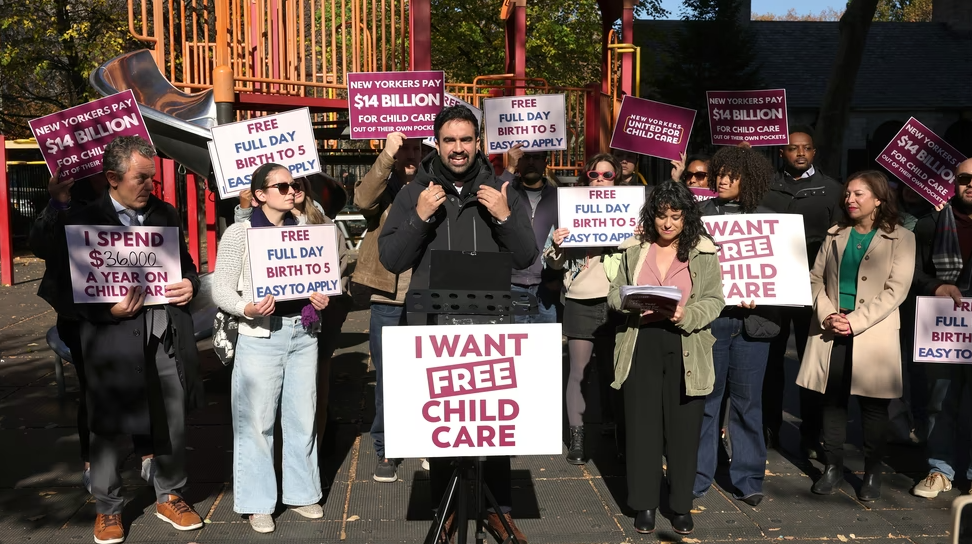
This article is more than
7 year oldWorld’s hottest shopping city is quickly becoming a ghost town

IF YOU want to see the future of storefront retailing, walk nine blocks along Broadway from 57th to 48th Street and count the stores.
The total number comes to precisely one — a tiny shop to buy drones.
That’s right: On a nine-block stretch of what’s arguably the world’s most famous avenue, steps south of the bustling Time Warner Center and the planned new Nordstrom department store, lies a shopping wasteland.
Yes, there are bank branches, restaurants, fast-food outlets, theatres, Duane Reades, a vitamin shop and a few tourist-targeted “discount” stores. But mainly there are oodles of empty spaces covered with signs touting SUPERB CORNER RETAIL OPPORTUNITY.
The same crisis blights the rest of Manhattan. The people invested in storefront retailing — real-estate developers, landlords and retail companies themselves — tell us not to worry. It’s a “transitional” situation that will right itself over time. Authoritative-sounding surveys by real-estate and retail companies claim that Manhattan’s overall vacancy is only just 10 per cent.
But they are all wrong. Bricks-and-mortar retail is shrinking so swiftly and on such a wide scale, it’s going to require big changes in how we plan our new buildings and our cities — although nobody wants to admit it.
Even the most profitable, can-do-no-wrong global chains are feeling the heat right now. H&M found itself unexpectedly sitting on $US4.3 billion ($AU5.6 billion) in unsold merchandise, The New York Times reported last month.

Why? Shopping from home or on a smartphone is a lot easier than shopping in a store. The ease of buying sweaters and light bulbs online trumps the thrill of people-watching in stores where slow-moving sales clerks take 15 minutes to ring up a $US25 ($AU32) tie on bulky computers.
Amazon makes it easier to return goods that don’t live up to expectations than it often is to buy things in stores. Clerks have no idea what’s in stock. Fashion goods displayed on shelves are chosen by too-young buyers with their minds more on the current Instagram trend than on customers’ needs.
I now buy many of my clothes from Charles Tyrwhitt online. Many more products offered there fit me than in their stores, where shirts seem cut for skeletons.
And yet, it’s scary to think that one of the city’s great pleasures, window-shopping — which also ensures vibrant, crime-deterring sidewalk life — will become a thing of the past except at certain locations.
At this rate, we face a future where streets will be mostly dark at sidewalk level for miles on end. Third Avenue in the East 60s, Broadway north of Lincoln Centre, many blocks in the supposedly thriving Meatpacking District are halfway there already.
Amazon and other online-buying services now account for 9.1 per cent of all national retail sales — soaring from just 5.1 per cent at the end of 2011, according to the US Census Bureau. Does anyone doubt that it will rise further?
Yet real-estate developers are adding to the surplus by putting millions of square feet of retail space into big new Manhattan mixed-use projects from the far West Side to Delancey Street. Just about every individual new office tower, apartment building and hotel opens with “prime” retail space in search of tenants. Super-luxury condo tower 432 Park Avenue has leased less than one-fifth of its store space after three years of trying.

Few retailers can afford to pay more than $US250 ($AU325) per square foot (0.09sq m) annually in rent — yet landlords persist in asking $US400 ($AU520) a square foot and up to $US2000 ($AU2605) a square foot in prime zones like Fifth Avenue and Times Square.
Mayor Bill de Blasio wants to fine landlords who keep spaces empty until they find tenants who’ll pay astronomical rents. But there’s no fair way to judge who’s actually guilty.
Would he punish the owners of the small corner building at 1330 Third Avenue at East 76th Street, who slashed the “ask” from $US420,000 ($AU547,000) a year in 2016 to $US360,000 (SAU469,000) in April 2017 and still can’t find a tenant?
New York’s vacancy crisis is due to the same factors that wiped out malls and chain stores across the United States: the rise of online shopping, private-equity takeovers that saddled retailers with too much debt, and shoppers’ changing tastes.
Only a few grasp the true scope of the problem. Vornado Realty Trust titan Steven Roth said we can only cure the national plague through “the closing and evaporation” of up to 30 per cent of the weakest space — which would take five years.
Most others see no evil. So what if JC Penney, Sears, Kmart, Macy’s, Toys ‘R’ Us, The Limited, American Apparel, BCBG, Payless Shoes, J. Crew, Banana Republic and Gap have closed (or plan to close soon) thousands of stores across the US, including many in New York City?
We’re told that although sportswear and appliance stores don’t appeal much to millennials, their places are being taken up by fancy coffee places, “fast-casual” eateries serving the same green salads, and gyms and spas. “Experiential” retail — a term that can mean almost anything — will also help plug the gaps.
But munching spots and health clubs can’t come close to filling spaces that sportswear, houseware and bookstores are leaving behind.
We can still avoid becoming a retail ghost town like many of the country’s malls. But to increase demand for our dark storefronts, the city must roll back zoning rules in some neighbourhoods that require even more retail in new buildings whether there’s demand for them or not. We should discourage the inclusion of acres of retail in giant new complexes that only add to the glut.
Otherwise, the whole town will look like Broadway in the 50s — a corridor of salad bars and dark windows.
This article was originally published in the New York Post and is republished with permission.




